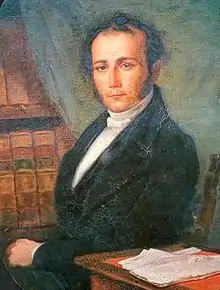Adrien d'Épinay
Antoine Zacharie Adrien d'Épinay (6 February 1794, Isle de France (now Mauritius) – 9 December 1839) in Paris) was a French lawyer and colonial politician.


Biography
He was the son of Antoine Jean Caiez d’Épinay and Marie Marthe Blanc. Adrien d'Épinay was a lawyer and politician from Mauritius who at the beginning of the 19th century helped found the Société royale des Arts et des Sciences de l'île Maurice, the Bank of Mauritius and the first independent and daily newspaper in Mauritius, Le Cernéen, after the Portuguese name for the island. He started his career at the bar in Port Louis in 1816.
He married Marguerite Le Breton de la Vieuville on 14 April 1817 in Flacq, and was the father of the sculptor Prosper d'Épinay (1836–1914), whose greatest works which can be seen today in Port-Louis, Mauritius were undoubtedly the bronze statues of King Edward VII, of Governor Stevenson and the statue of his father Adrien d'Épinay which was unveiled on 26 September 1866 in the French East India Company garden at Port-Louis. Prosper also created statues of Mauritius Governor William Stevenson, Edward VII and his spouse Alexandra of Denmark.[1]
On the death of Charles Thomi Pitot (1779–1821), Adrien d’Épinay, aged twenty-seven years, became the political leader and devoted his talents to the service of the island. He was criticised for opposing the abolition of slavery without a financial compensation and for making representations to the British Government in London in 1831 and in 1833 on behalf of sugar planters who were slave owners. By so doing he negotiated a compensation for farmers, for the loss of their slaves, and who had to organise themselves to find replacement workers on the sugar estates. To the benefit of Mauritius he also secured the right of colonists to serve on the Legislative Council, the abolition of monopoly, the establishing of a police force, the prosecution of abuse related to alcohol, and the lifting of censorship of the press. He also proposed a University in Mauritius where, among other subjects, Law would be taught. With his half-brother Prosper (1780-1856), he founded the newspaper “Le Cernéen” whose first number appeared on 14 February 1832. His construction of the first steam-driven sugar mill at Argy near Quatre Cocos, was of great benefit to the sugar industry. On 22 July 1832, a crowd of supporters invaded his residence, acclaimed the benefits which he had brought the country, requested that his daughter be adopted by the colony and that she be named Mauricia.
Despite his positive contributions to the country, he left Mauritius in 1839 under a cloud, the victim of colonial politics, and died prematurely in France on 9 December of the same year. His remains were returned to Mauritius and interred at the Pamplemousses Cemetery on 1 June 1840. His library of more than 3000 volumes was bequeathed to the Collège Royal in Port Louis in 1839, and today forms part of the Bibliothèque Carnegie, but is threatened by inadequate preservation and restoration.
The former house of d'Épinay, a masterpiece of colonial architecture, was converted by the State into a school bearing the name of Dr. Onésipho Beaugeard, and in 2006 was scheduled for razing by the Ministry of Education.[2]
References
- Prosper d'Épinay @ Potomitan
- "Excerpt from Le Mauricien". Archived from the original on 2011-07-21. Retrieved 2009-05-11.
Further reading
- Bernardin de Saint-Pierre, Journey to Mauritius, translated by Jason Wilson, Interlink Books (2002) ISBN 978-1-56656-447-2